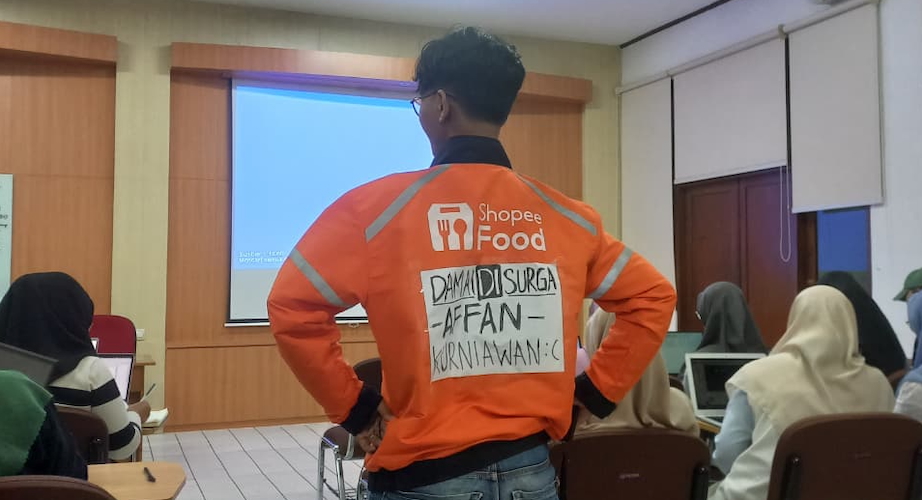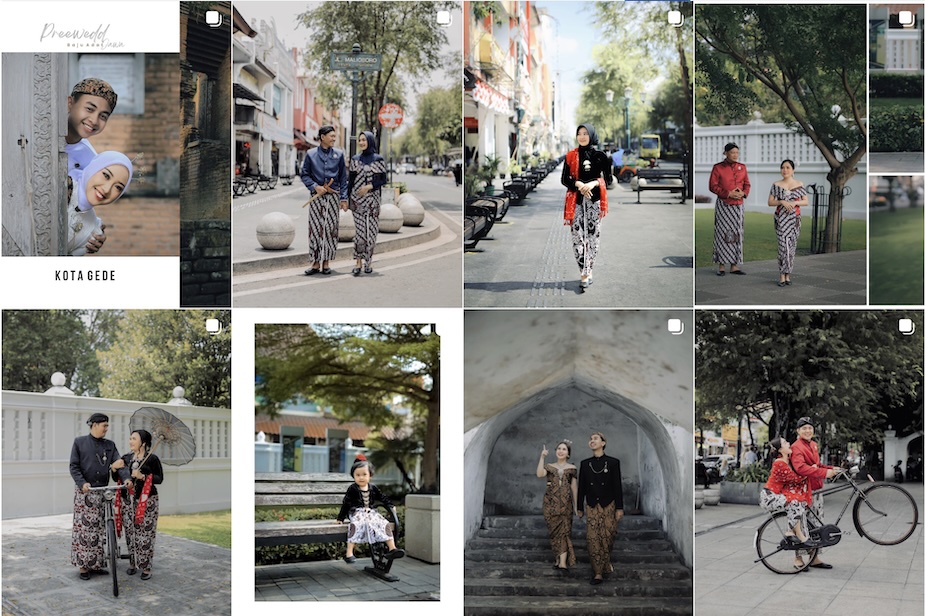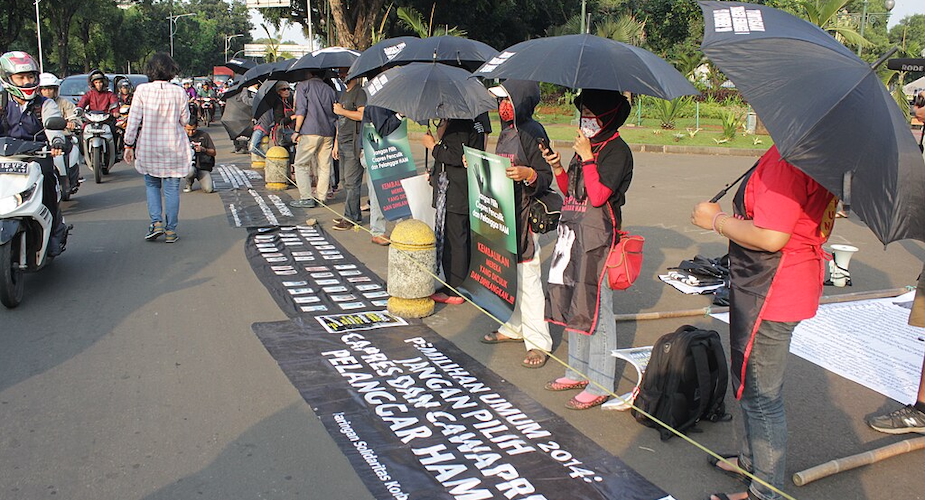This recent tragedy profoundly affected young people in Yogyakarta, and across the country
On the morning of 29 August 2025, a student arrived at a university classroom in Yogyakarta dressed in an orange Shopee Food jacket. An A4-sized piece of paper was taped to his back with the words ‘Damai di Surga (Peace in Heaven) Affan Kurniawan’ inscribed on it.
The student’s name is Cokro. He is the son of a farmer who works the land near Solo, Central Java. Cokro came to Yogyakarta to study and covers his tuition and living expenses working as an app-based courier for the food delivery service Shopee Food. During the harvest season, he will return home to help his parents on the farm.
The news and video footage of the death of Affan the previous evening, sent shockwaves across the country. He was crushed by a police tactical vehicle that was pursuing a crowd of protesters outside the national parliament in Jakarta. Ironically, Affan, 21-year-old and the main provider for his family, was not part of the protest. He was reportedly on his way to fulfil an order from the delivery app he worked for. He was struck by the speeding heavy vehicle as he reached for his dropped smartphone.
The news of Affan’s death was communicated immediately through the community of app delivery drivers. In Yogyakarta, Cokro and his colleagues were told that a meeting would be held the following day at the Terban campus of Indonesia Islam University (UII) in Yogyakarta, initiated by Aliansi Jogja Memanggil.
Affan Kurniawan’s tragic death had a profound impact on Cokro. Like him, Affan was a young app driver struggling to pay for his education and support his family. Cokro felt compelled to express his sympathy. When he arrived on campus the next morning wearing a condolence patch on his jacket, his classmates were not surprised. Many of them shared his sense of shock and frustration. ‘I hardly slept that night,’ one student confessed. ‘I was completing my work when the news emerged. I was saddened, all of the sudden. He is so young. He has family. He had a future ahead of him. Now he is dead. Thanks to the police.’ The gesture proved to be fruitful. Some of his classmates agreed to follow Cokro that afternoon to the gathering in Terban.
Rising discontent
The first 100 days of the Prabowo Subianto government had already been marked by widespread rising public frustration due to the introduction of a raft of controversial policies and taxes increases. Mass protests during February 2025, largely led by students and labelled ‘Indonesia Gelap’ (Dark Indonesia), saw the hashtags #IndonesiaGelap and #KaburAjaDulu (JustEscapeFirst) go viral on social media.
Amid this rising discontent and increasingly uncertain economic conditions, including growing youth unemployment, in mid-August the House of Representative (DPR) agreed to an increase in allowances of over Rp.100,000,000 (A$6084) for every DPR member.
Less than a week later, on 25 August a demonstration opposing the increased allowance and other policy concerns took place in the front of the House of Representatives (DPR) building in Senayan, downtown Jakarta. In a press conference a few days earlier Chairperson of the DPR and PDI-P politician Puan Maharani, had addressed the call for protest, stating, ‘God willing (InsyaAllah), those who give their aspiration would be welcomed here.’
When the protesters arrived on 25 August to voice their concerns to the parliament, the gates were locked and concrete barriers covered with motor grease placed in front of them. As the protest grew in front of the gates not a single DPR member came out to ‘greet’ them as Puan Maharani had promised. The protest ended in violent clashes between the security forces and protesters as the police tried to move the crowd on.
On 28 August the protesters returned, made up largely of workers demanding better conditions, and calling for the increase in parliamentary allowances to be thrown out. That day many DPR members were working from their own residences, as encouraged by General Secretary of the DPR. In fact, the advice to ‘work from home’ was used by some DPR members as an opportunity to leave the country altogether.
As night approached the protest turned chaotic. Some people tried to climb the fences and threw stones at the gates to the parliament. At this point the security forces acted, dispersing the crowds toward the areas of Senayan, Slipi and Pejompongan. In Pejompongan a fast-moving police tactical vehicle charged the crowd, killing Affan Kurniawan and injuring others.
Appeal for ‘solidarity action’
In Yogyakarta the next day, Cokro and a group of his classmates attended the gathering at UII campus in Terban. It was agreed that a protest would be held on the following Monday, 1 September. But the Alliance also decided to take immediate ‘solidarity action’ at the Yogyakarta Regional Police (Polda) station, located on North Ring Road.

From the start, the atmosphere at the meeting at UII Terban was extremely tense. One of Cokro’s classmates at the meeting, Surya, explained that that the Alliance really had no other choice but to agree to the immediate ‘solidarity action’. ‘The mass gathered there was varied. There were some people sitting by the gate, shouting whenever they had the opportunity. I don’t know if they are students, app drivers, sympathiser, or worse… provocateurs. Whoever they were, they wanted to take action right after the meeting. Judging by the situation and how ‘fresh’ it all was, I think the Alliance was pressed to agree’.
Just after 6pm, Cokro, Surya and six other friends arrived at the North Ring Road. At first, he believed the ‘action’ would proceed peacefully. Then suddenly the crowd began to turn its rage on anyone on the street who was filming or taking photographs with their smartphones. ‘A Trans Jogja bus was allowed to pass the street slowly. (Then) some people in the street saw one of the passengers taking photos. They started to shout, “No photo!” (Gak boleh foto!). Then the crowd swarmed the bus. They almost forced the bus door open!’
On the Ring Road members of the crowd shouted at vehicles with police or military markings. Someone set something alight in front of the Polda station and smoke rose into the night sky. The air was full of the smell of spray paint – someone might have been writing something on the gate or walls – and the thumping sound of the station’s gate being rammed by the crowds.
A moment later, an alert went out warning of tear gas. The crowd immediately started running away from the station, dispersing into the laneways. A man assisting someone who had been affected by the tear gas begged a bank security guard to give them water. Someone in a hoodie handed them toothpaste; they smeared it around the victim’s eyes.
Surya had become separated from the group and it was a while before he found them gathered near the Pakuwon Mall sign, where they were trying to avoid the crowd. Cokro concluded that there is no way they could participate in the ‘solidarity action’ much longer. ‘It wouldn’t be peaceful, trust me,’ he told them. Cokro predicted the crowd would grow wilder into the night. It was almost 8pm when they started for home.
It was several hours later, when he reached the corner of Kaliurang Road, that Surya was able to eventually find a phone signal. An update on Instagram reported that a car in the parking area of the Polda station had been destroyed by fire.
The following night the protesters returned to continue their protest on the North Ring Road. One protestor, Rheza Sendy Pratama, a student of the College of Informatics and Computer Management (known as Universitas AMIKOM), was taken to Dr. Sardjito hospital where he was declared dead on Sunday morning. A further 29 people involved in the protest were also hospitalised. Cokro’s prediction that the protests would not end peacefully was unfortunately, proven to be true.
The risk of chaos
Yogyakarta was one of several major cities in Indonesia that experienced mass chaos on 29 August. Government buildings, police stations, universities and public facilities became targets for destruction and arson. Police were deployed to push the crowds back, mostly with tear gas, but a recent update shows that police also committed acts of violence and shooting. In Jakarta, on 30-31 August houses owned by some DPR members become targets of mass looting.
Surya expressed his concern about the looting. ‘Some opinions on social media say it's impossible for people to loot freely. The authorities must have allowed the looting,’ he commented. Echoing opinions trending across social media at the time, Surya wondered if the authorities had allowed the looting to take place in order to create social unrest and enable the government to declare martial law.
‘Although Affan Kurniawan died because of the police,’ Surya commented, ‘it’s important to realise that the core of our problem is rooted in our government.’ Various theories also circulated on social media speculating that the government was using Affan Kurniawan’s death to divert public anger from the government onto the police. Through social media platforms like Instagram, public figures, influencers and mass organisations urged citizens to be more careful in directing their anger.
Affan Kurniawan’s tragic death has proved to be a definitive moment for many Indonesians. ‘It is the tragedy that moves us to struggle and claim our rights,’ Surya stressed. But he also knows that danger could come from within. As Cokro, Surya and their friends discovered, taking action also carries risks. People’s sympathies and anger are genuine. They are tired of their government, and this tragedy has shocked them deeply. But they should also stay alert to the real possibilities of ‘planned chaos’ and ‘provocateurs’ playing a part.
Rahmadi Fajar Himawan (hima0813@gmail.com) graduated from the Department of Sociology at Universitas Indonesia and is currently pursuing his Masters degree at Universitas Gadjah Mada. The names of people mentioned in this story have been changed.
This article is part of a Collection of articles examining the August 2025 protests.











